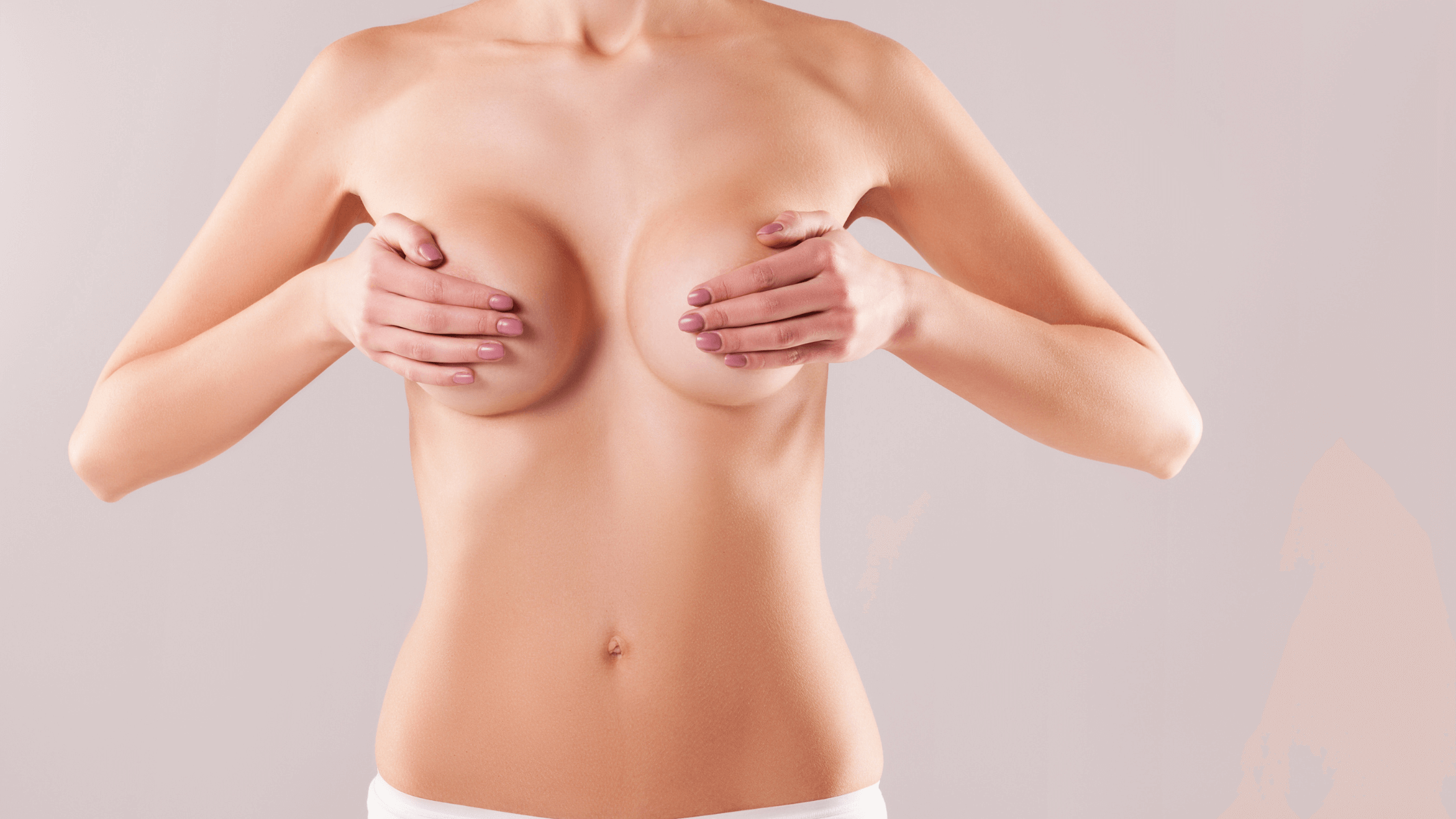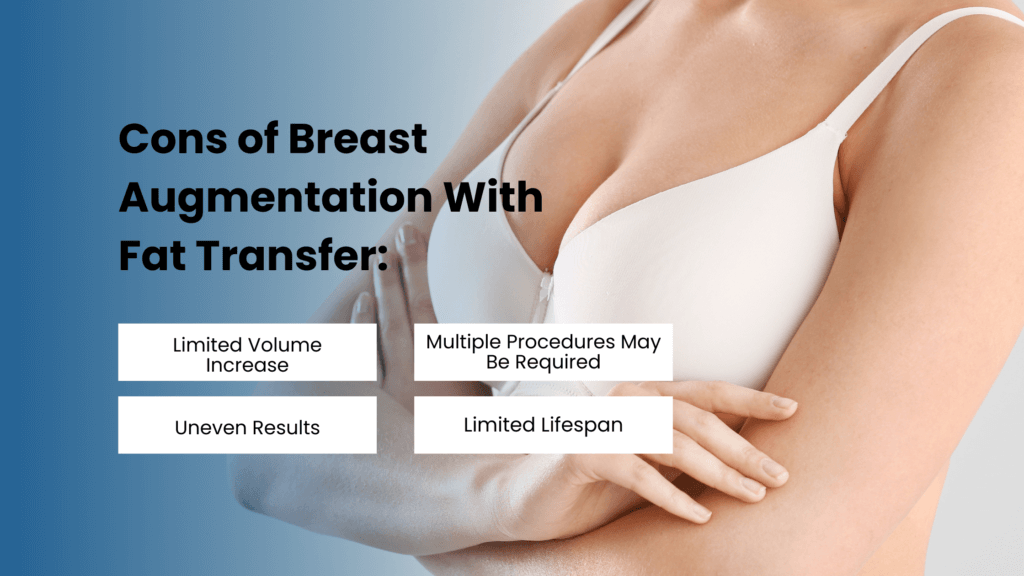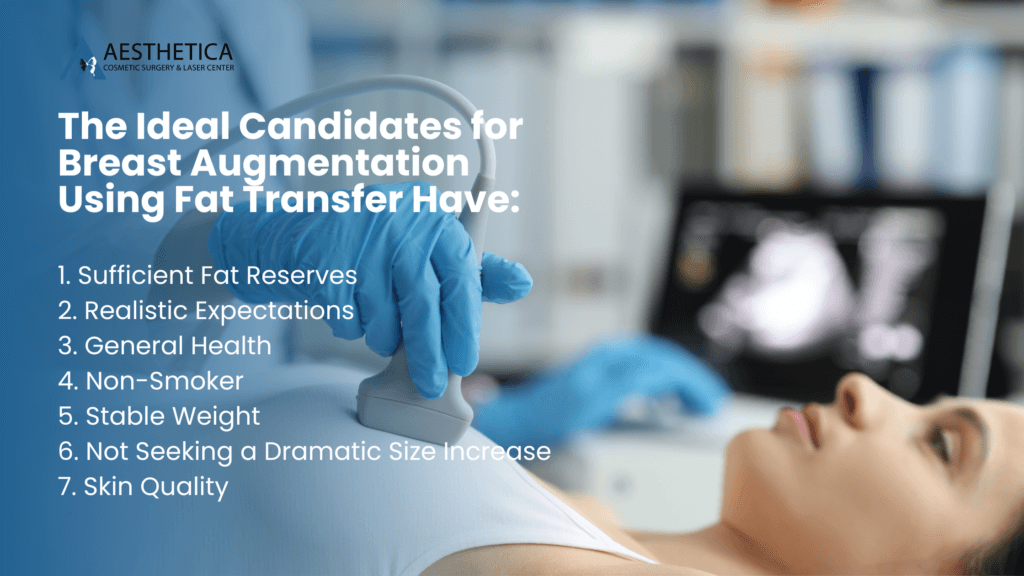Pros and Cons of Using Fat Transfer for Breast Enhancement8 min read
- , Breast

Aesthetica Editorial Team

If you’re considering breast enhancement surgery, you may be weighing the pros and cons of breast augmentation with fat transfer versus implants.
Both options offer unique benefits and drawbacks, and choosing the right one for you may come down to your personal preferences and goals.
Fat transfer breast augmentation uses your own fat to create a more natural-looking result. At the same time, implants provide a greater increase in volume and better control over the final size and shape.
So, what are the pros and cons of breast augmentation with fat transfer versus implants, and how do you know which one is right for you?
Fat Transfer Breast Augmentation vs. Implants: What's the Difference?
Fat transfer and breast implants are two different options for enhancing breast size and shape.
Fat transfer uses the patient’s fat and is typically performed as a minimally invasive procedure, where fat is removed from one area of the body, processed, and then reinjected into the breasts.
The procedure results in a more natural-looking appearance and has a quicker recovery time compared to breast implants.
Implants, on the other hand, consist of artificial materials, such as silicone or saline, that are inserted into the breasts through a more invasive surgical procedure.
Breast implants offer a more significant volume increase and better control over the final size and shape of the breasts. Still, they can result in a more artificial appearance.
Because the volume increase that can be achieved via fat transfer is relatively small, fat transfers are typically used alongside other forms of breast augmentation rather than by themselves.
What are the Pros and Cons of a Fat Transfer?

Pros of fat transfer breast enhancements include:
- Natural-Looking Results: Fat transfer uses the patient’s own fat, so the results are often more natural-looking and subtle than traditional breast implants.
- No Artificial Materials: The absence of synthetic materials reduces the risk of implant-related complications.
- Minimally Invasive: Fat transfer is typically performed as a minimally invasive procedure, resulting in less scarring, less pain, and a faster recovery period.
- Improved Body Contours: By removing excess fat from one area of the body and transferring it to the breasts, fat transfer can result in an overall improved body contour.
- Lower Risk of Complications: A fat transfer breast enhancement is generally safer than implants.

Cons of fat transfer breast enhancements include:
- Limited Volume Increase: Fat transfer may not be suitable for women seeking a significant increase in size.
- Uneven Results: Fat transfer results may result in irregular breast size or shape, requiring additional procedures to achieve the desired results.
- Limited Lifespan: Unlike traditional implants, fat transfer results are not permanent, as some of the transferred fat may be reabsorbed by the body over time.
- Multiple Procedures May Be Required: Depending on the amount of fat available for transfer, additional procedures may be necessary to achieve the desired results.
Is a Breast Enhancement Fat Transfer Safe?
Dr. Chang’s comprehensive approach to patient care includes thorough preoperative assessment and state-of-the-art equipment to ensure precision and care throughout the procedure.
His dedication to your safety is matched only by his commitment to achieving the beautiful, natural-looking results you desire!
What Should You Know About Fat Transfer Breast Augmentation Risks?
Side effects include dizziness, headaches, blurry vision, numbness, and weakness. These effects are uncommon, but patients should discuss their medical history with the plastic surgeon to ensure that risks are understood.
The risk of infection is low but still present. Although the procedure creates only tiny incisions and uses the patient’s own fat, infection is possible. Those with a weakened immune system should consult with a doctor to ensure that the procedure is a good fit for them.
Fat necrosis is the most significant risk associated with fat transfer procedures. It occurs when adipose cells die during the transfer process. If many cells die, they may create painful cysts or lumps, bruising, skin discoloration, and even a change in the overall shape of the breast.
Some lumps may resolve on their own, but those that cause significant pain should be treated. In the worst-case scenario, a surgeon may have to remove the lumps.
Navigating Fat Transfer Breast Augmentation Scars
Fat transfer breast augmentation results in minimal scarring compared to traditional breast implants!
This is due to the less invasive nature of fat transfer, which uses liposuction to harvest fat from other areas of your body, requiring only small incisions.
These incisions are no larger than a few millimeters. Also, they are strategically placed in inconspicuous areas to ensure they are as discreet as possible.
In contrast, breast implant procedures generally call for larger incisions to accommodate the implant, resulting in more noticeable scars.
Dr. Chang is adept at minimizing and carefully placing all types of breast augmentation incisions, further reducing the visibility of any potential scarring!
What is the Recovery Period for Fat Transfer?
The results of a fat transfer breast augmentation are designed to look and feel natural.
The added volume typically offers a subtle yet noticeable improvement, avoiding the potential for an overly “done” appearance that sometimes occurs with implants.
While some of the transferred fat may be reabsorbed by the body initially, Dr. Chang’s technique is refined to optimize retention for long-lasting results!
What are Fat Transfer Breast Augmentation Results Like?
The recovery period following a breast augmentation with fat transfer typically takes several weeks, although it varies from patient to patient.
During this time, patients may experience swelling, bruising, and discomfort in the treatment area. Still, these side effects should subside within a few days. It’s important to follow your healthcare provider’s instructions regarding postoperative care, such as wearing a compression garment, to promote proper healing and reduce the risk of complications.
Most patients return to work and daily activities within a week. Still, they should avoid strenuous activity or heavy lifting for several weeks to allow the treated area to fully heal.
The final results of a fat transfer breast augmentation may not be fully visible for several weeks or months, as the transferred fat takes time to settle into its final position.
What Happens to the Fat Transfer After 5 Years?
Fat transfers are somewhat unpredictable; some adipose cells will inevitably die during the process.
The results may look uneven and require touch-ups.
Furthermore, the results of a fat transfer behave like normal body fat–they will fluctuate in response to weight loss or gain.
Still, any fat that survives the procedure should require little maintenance and last far longer than a typical implant.
Are You the Right Candidate for Breast Augmentation Using Fat Transfer?

Determining if you are an ideal candidate for breast augmentation using fat transfer involves several considerations.
Here are some key points to evaluate:
- Sufficient Fat Reserves: Candidates must have enough body fat in other areas to be harvested for the procedure.
- Realistic Expectations: Fat transfer results are typically more subtle than those with implants.
- General Health: Patients must be in good overall health with no underlying conditions that could complicate surgery or healing.
- Non-Smoker: Smoking impairs healing and increases the risk of complications.
- Stable Weight: Weight fluctuations affect the longevity of the results.
- Not Seeking a Dramatic Size Increase: Fat transfer is ideal for women seeking a modest increase in breast volume.
- Skin Quality: Optimal skin elasticity helps achieve and preserve optimal results.
How Much Does Fat Transfer Breast Augmentation Cost?
The cost of a fat transfer breast augmentation is an investment in the expertise, precision, and aesthetic excellence Dr. Chang brings to each surgery!
Prices vary depending on individual needs and the extent of the procedure.
We understand that cost is a factor, so our cosmetic center offers assistance in finding low-interest financing options to help bring your aesthetic goals to life. We aim to provide access to Dr. Chang’s sought-after surgical skills while keeping the process financially manageable for you!
Ready for a Naturally Fuller Look? Schedule Your Fat Transfer Consultation Today!
Meet us at 19500 Sandridge Way, Suite 350, Leesburg, VA 20176, or call us at (703) 574-4342 for a complimentary consultation with Board-Certified Plastic Surgeon Dr. Phillip Chang before moving forward with your procedure. If everything matches up, our team will help you navigate the entire process from beginning to end. Also, remember to check out our blog and social media for more information on cosmetic surgery trends!
Let Us Help You!
Our office can provide you with helpful information, schedule a free consultation, and walk you through the many services and procedures we provide.
Contact Dr. Chang's Office:
More Articles For You

The Latest Techniques in Double Chin Removal in Leesburg, VA
In the charming town of Leesburg, VA, where looking good and feeling great are top

The Art of Refining the Side Profile of a Woman through Plastic Surgery
In the realm of cosmetic enhancements, the side profile of a woman holds a pivotal

Enhance Now, Pay Later: Plastic Surgery Payment Plans in Leesburg, VA
In the picturesque town of Leesburg, VA, pursuing beauty and self-improvement is a journey many

Areola Reduction for Men in Loudoun County
In the heart of Loudoun County, where the beauty of nature meets bustling urban life,
